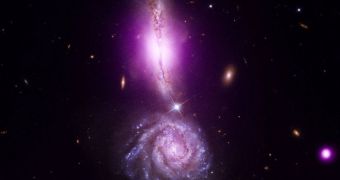Astronomers surveying the night sky using two of NASA's best telescope were able to capture a new photo of the VV 340 galactic system, which features two galaxies in the process of colliding with each other. From a distance, the system looks like an enormous exclamation point in space.
The bright galaxies are called VV 340 North (on top) and VV 340 South (at the bottom). They take on this interesting shape because North is seen edge-on, whereas South appears face-on as seen from our vantage point.
NASA released this image on Thursday, August 11, alongside a video explaining how the system works. Over the past few years, astronomers have identified numerous instances of galactic collisions, featuring two to five galaxies in the act of merging together.
According to the American space agency, this particular system is located around 450 million light-years away, and is also known as Arp 302. At this time, the two galaxies are engaged in a gravitational dance that will eventually see them becoming a single, massive galaxy.
The supermassive black holes powering up their cores will most likely merge as well. The alternative scenario is the one in which one of these dark behemoths is cast our of the newly-formed galaxy.
As the two draw closer to each other, tidal and gravitational forces will stir up the gas in both the structures, leading to bouts of intense stellar formation. Numerous blue stars will be created over the next tens of millions of years, the experts say.
In order to capture this highly-detailed view of the system, astronomers combined data collected by the NASA/ESA Hubble Space Telescope with images captured by the Chandra X-ray Observatory.
Hubble was used because it can capture views in near-infrared wavelengths. VV 340 is classified as a Luminous Infrared Galaxy (LIG), which means that it shines bright in this region of the electromagnetic spectrum, Space reports.
Billions of years from now, our own galaxy will begin a similar “dance” with our closest neighbor, the Andromeda Galaxy. Hundreds of millions of years after that, the merger will be complete, and this region of space will most likely be dominated by an impressive elliptical galaxy.
In addition to Chandra and Hubble, the Spitzer Space Telescope, the Galaxy Evolution Explorer (GALEX) observatory, and other ground-based telescopes are also a part of the Great Observatories All-Sky Luminous Infrared Galaxy Survey.
The new research was conducted as part of this survey, experts conclude.

 14 DAY TRIAL //
14 DAY TRIAL //